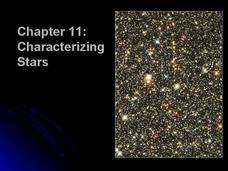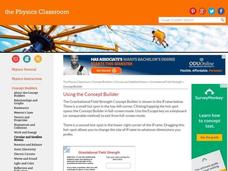Pingry School
Mole Relationship in a Chemical Reaction
What do budding scientists know about moles and reactions? Using an attention-grabbing lab experiment, young scholars collect data to apply the law of conservation of mass to predict the mass of gaseous products. They examine several...
Pingry School
Isotopes and Atomic Mass – Determination of the Average Atomic Mass of Pastium
Sometimes modeling is the best approach to working with microscopic particles. A lab investigation models a fictional element using pasta. The setup uses three different pasta types to represent three different isotopes. Learners...
Glynn County School System
Characterizing Stars
Are brighter stars actually brighter? Turns out they are probably just closer! A presentation compares features of stars to our favorite star, the sun. In addition, solar lovers learn to classify stars based on their masses,...
Magic of Physics
Planetary Rescue Squad
Ready, aim ... learn! Increase scholars' understanding of force, mass, distance, and angle using an engaging interactive. Pupils participate in a series of rescue missions where they launch supplies at a target with an adjustable cannon....
Physics Classroom
Fnet = m•a
Most pupils learn quickly how to apply Newton's Second Law equation to calculate net force. However, many struggle to determine net force before calculating the value of an unknown force from a force diagram. As part of a larger series...
Physics Classroom
Gravitational Field Strength
Budding scientists fall hard for a gravitational field strength activity! Physics pupils compare the masses and distances relative to the center of planets using an interactive from a Circular and Satellite Motion series. Individuals...
Physics Classroom
Torque-ing About Rotation
Let's talk torque! Science scholars evaluate experimental setups during an interactive from the Rotation and Balance series. Individuals calculate the torque of differently arranged weights to determine the effect they have on a balanced...
Physics Classroom
Universal Gravitation
Are you feeling weighed down by your current gravitation presentation? Assign a hands-on interactive instead! Physics scholars work through a series of progressively harder questions about mass, distance, and gravity using an online...
Physics Classroom
Getting a Handle on Torque
Do your young physicists get a little unbalanced when it comes to talking about torque? Scholars examine the effects of weight and distance on a balanced system with a simple interactive from the Rotation and Balance series. The resource...
Physics Classroom
Law Enforcement - Hit-and-Stick Collisions
How do police determine the speed of a car that has hit a stopped vehicle? Scholars determine the momentum of the car system both before and after a collision. They identify instances where the law of conservation of momentum appears to...
Physics Classroom
Case Studies: Impulse and Force
Why are gym walls padded and cars required to have air bags? Scholars observe two similar situations, such as those listed above, with only one variable altered. They identify the different variable and determine how the variation...
Physics Classroom
Law Enforcement - Explosions
How do law enforcement officers determine the strength of an explosion based on the movement of objects around the point of origin? Scholars inspect the relative mass and velocities of two cars before and after an explosion. They perform...
Community Resources for Science
Spring Mechanics
Scholars practice calculating spring constants before performing hands-on experiments. They compare data for parallel and series springs. Finally, they learn how spring mechanics find applications in biotechnology, such as prosthetic limbs.
Serendip
Where Does a Plant's Mass Come From?
Where does the mass for a growing tree come from? Scholars consider a few different hypotheses and guess which is correct. They then analyze data from different experiments to understand which concepts science supports.
Kenan Fellows
Density
Most scholars associate density with floating, but how do scientists determine the exact density of an unknown liquid? The third lesson in a seven-part series challenges scholars to find the mass and volume of two unknown liquids. Each...
101 Questions
Super Bear
Bear with your classes as they explore unit rate and proportions using gummies! Gummy bears come in many different sizes, including a 2,250-gram super bear! The task asks learners to determine how many regular bears and how many mini...
Nuffield Foundation
Investigating the Effect of Concentration of Blackcurrant Squash on Osmosis in Chipped Potatoes
Model and explore osmosis using squash and potatoes. Young scientists expose chunks of potatoes to different concentrations of a squash solution. They compare the weights of the chunks before and after exposure to the solution and use...
National Research Center for Career and Technical Education
Lou-Vee-Air Car
Who said teaching a STEM lesson had to be challenging? Incorporate a career and technology-centered car build into your upcoming force lesson plan, and your class will be moving down the road in no time! Pupils practice...
Teach Engineering
Equal and Opposite Thrust in Aircraft: You're a Pushover!
It's the law—every action requires a reaction, no matter how small. Pupils experience two demonstrations of Newton's third law of motion as it relates to thrust in the 10th segment of a 22-part unit on flight. Using their mathematical...
Teach Engineering
Physics Tug of War
Slide books with a little assistance from Newton. Using books, groups create a demonstration of Newton's Second Law of motion. Pupils compare the distance traveled by one and two books when they apply a force to them.
Teach Engineering
Floaters and Sinkers
Whatever floats your boat. Young engineers learn about density by measuring the masses and volumes of boxes filled with different materials. Using their knowledge of densities, they hypothesize whether objects with given densities will...
Chemistry Collective
Virtual Lab: Making Stock Solutions from Solids
Combine a little solid and a little water and the solution is clear! An experimental lesson has individuals make calculations to create a sample solution of a given volume and molarity. They then create the solutions using a virtual lab...
Teach Engineering
May the Force Be with You: Weight
Too much material will weigh you down. The sixth segment in a series of 22 highlights how weight affects a plane. Pupils learn that engineers take the properties of materials, including weight, when designing something.
Royal Society of Chemistry
Symbols
Chemistry calculations can look a bit like alphabet soup at times. How do you help pupils make sense of it all? An interactive resource helps scholars sort through the symbols for common quantities such as moles, boiling point, and...

























